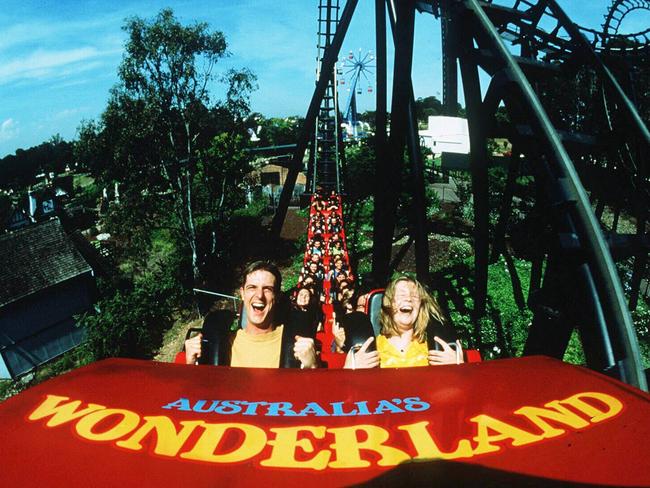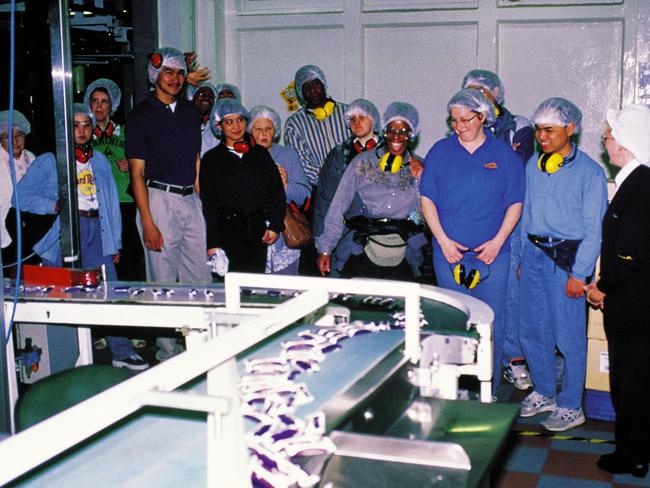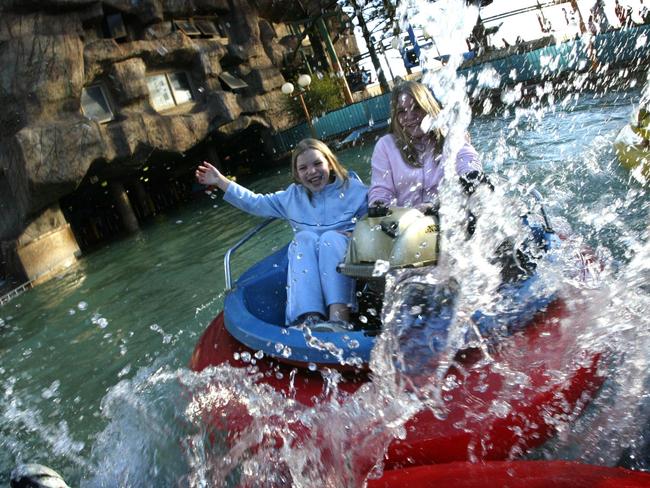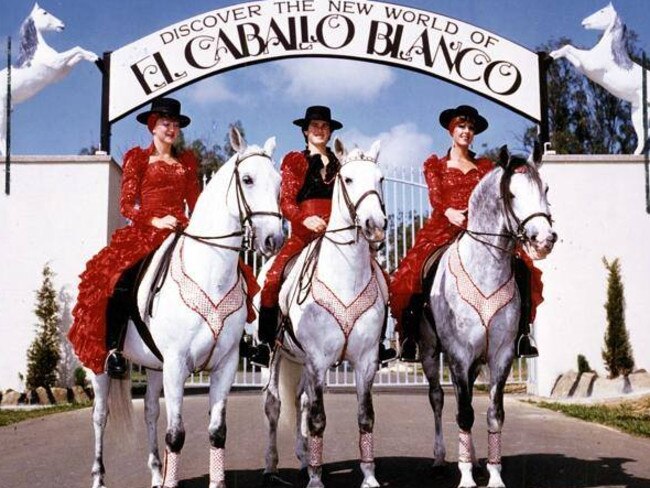The holiday spots from our childhoods that don’t exist anymore
FROM theme parks to quirky roadside attractions, these places delighted generations of youngsters until they disappeared — but they’re never forgotten.
THEY used to be the highlights of our family holidays as kids and now they’re nothing but childhood memories.
From theme parks to quirky roadside attractions, these places delighted generations of Aussie youngsters until they bit the dust, serving as a harsh lesson on how cruel the real world could be.
But while they are gone, they won’t be forgotten. Here are a few of Australia’s most fondly remembered former tourist spots.
WONDERLAND SYDNEY, NSW



Who could forget the Bush Beast, the Demon, Hanna-Barbera Land and Space Probe 7 at Wonderland in Sydney’s western suburbs?
From the day it opened in 1985, Wonderland drew thrillseekers from near and far. And for Sydney kids in the 1980s and 90s, it was the happiest place on earth.
Dreams were shattered in 2004 when the park shut its doors for a final time after years of tumbling profits, and it was demolished soon after.
But Wonderland nostalgia is still as strong as ever, and last year there was talk it would be resurrected as a Worlds of Wonder theme park.
CADBURY VISITOR CENTRE, TASMANIA


For generations of Aussie kids, this was a real-life Willy Wonka factory: a place where you could see how chocolate was made and chow down on as many free samples as you could cram in your little mouth.
The Cadbury Visitor Centre, which opened at the site of the Claremont Cadbury factory in 1948, was one of Hobart’s top tourist attractions and a must-see for visiting families.
But while the factory continues to manufacture Cadbury chocolate, the famous visitor’s centre was shut down in 2015, disappointing absolutely everyone.
“The Cadbury factory has been in the Glenorchy municipality since 1921 and we’re certainly very fond of it. I can remember as a child stuffing my pockets full of chocolates on the [factory] tour,” local mayor Kristie Johnston said at the time.
MAGIC MOUNTAIN, SOUTH AUSTRALIA


It looked a bit like a giant dog poo, but to Adelaide kids in the 80s and 90s, Magic Mountain was the bee’s knees.
The theme park in beachside Glenelg was a favourite for young families and teenagers with its rides and giant water slides — which were the largest water slides in the southern hemisphere for a while — as well as a mini-golf course, dodgem cars, a shooting gallery and games arcades.
It was widely considered a local eyesore, but during the school holidays, Magic Mountain was where you needed to be.
After 22 glorious years, the park was shut down in 2004. It was replaced with The Beachouse, a major family entertainment complex which, while impressive, doesn’t have quite the sparkle of old Magic Mountain.
LEYLAND BROTHERS WORLD, NSW


Anyone who’s road-tripped up and down the Pacific Highway on Australia’s east coast has probably stopped for a petrol and loo break at a faded replica Uluru around North Arm Cove, north of Newcastle.
Back in the 1990s, this decrepit old spot was Leyland Brothers World, a theme park built by documentary filmmakers and explorers Mike and Mal Leyland.
It had rides, a playground, museum, bush camp and most famous of all, that 1/40 scale replica of Australia’s most iconic rock.
Soon after it opened, the Leyland brothers fell into financial trouble and now, the sun-faded rock is the only reminder of their now-defunct park — although the bush camp is still going strong.
BULLENS AFRICAN LION SAFARI, VICTORIA

Believe it or not, lions once roamed free — kind of — in Rockbank, just outside Melbourne.
Bullens African Lion Safari, which operated during the 1970s, was a drive-through safari packed with real lions, tigers, elephants, giraffes and bears. (There are a few sister parks elsewhere, such as in Beenleigh, Queensland and Warragamba, NSW.)
Families could drive through the park, occasionally becoming genuinely terrified whenever one of the park’s growling residents came too close.
The safari was operated by the Bullens, a well-known circus family. Things didn’t always go to plan — a man was believed to have become seriously injured when a bear attacked him through his car window in 1977.
It’s perhaps no surprise the safari didn’t last long, and a nursery and restaurant now sit where the exotic animals once roamed.
OLD SYDNEY TOWN, NSW


This open-air museum, just outside Gosford, was a tourist destination in its own right. But for generations of primary school kids, Old Sydney Town was a highly anticipated school excursion spot, where all those lessons on Australia’s colonial past were suddenly brought to life.
There were actors dressed as soldiers and convicts, a gallows and magistrates court, horse-drawn carriages and cannons, plus craft stores and old-fashioned lolly shops in faithfully recreated early-19th century buildings.
A highlight was the re-enactment of convicts being lashed with the dreaded cat o’ nine tails, which always drew screams of excitement from the older kids and genuine terror from the younger ones.
The site was first opened by Gough Whitlam in 1975 and welcomed about six million visitors before it was closed in 2003. These days, the site is occasionally used as a filming location.
THE BIG COW, QUEENSLAND

Australia has a wonderful tradition of Big Things, from the Big Banana and the Big Pineapple to the Big Prawn and the Big Golden Guitar.
The Big Cow, at Kulangoor in the Sunshine Coast, was among them. The 15-metre-tall bovine with big, bulging eyes was built in the 1970s on the site of a dairy farm and instantly became a pit stop for a family holiday snap.
But with a decline in interest from tourists, the Big Cow — along with the Big Macadamia Nut, another Sunshine Coast institution — fell into disrepair and closed in 2016.
Visit Sunshine Coast chief executive Simon Ambrose told the ABC while Big Things were icons in the 1980s and 90s, tourists of today just weren’t interested.


EL CABALLO BLANCO, NSW
Semi-rural Catherine Field on the outskirts of Sydney used to be as close to Spain as holidaying families could get.
The suburb was home to El Caballo Blanco (“the white horse”) a theme park where the main attraction were Andalusian dancing stallions who would perform for crowds in a lavish arena.
The park was opened in 1972 by West Australian entrepreneur Ray Williams, who would later establish the El Caballo Blanco park at Disneyland, California. (He’d previously built a similar park in WA.)
The Catherine Field park also featured miniature Fallabella horses, water slides, train rides and a mini zoo.
But operations wound down after Williams’ death and by 2003 the dancing horses had performed for the last time. The abandoned site was used for functions and rave parties until a devastating fire in 2007 finally put an end to all the fun.

